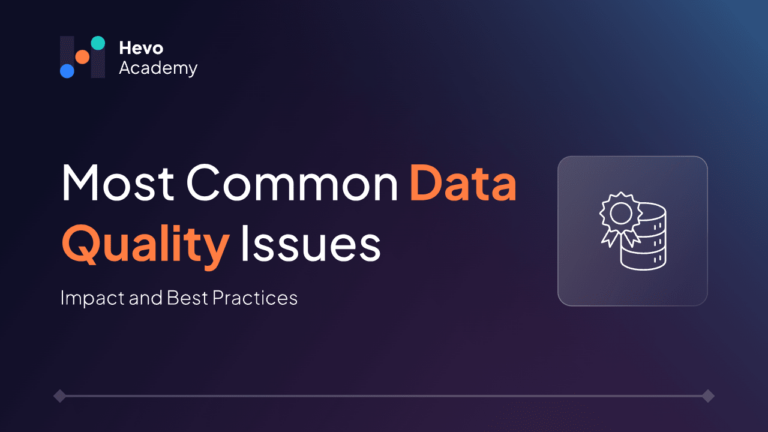In today’s world, data quality is one of the main indicators of an organization’s success. Accurate information reflects efficient decisions, improves an organization’s financial status, and guarantees new ventures [Gartner, 2022 Report on Data Quality]. However, inadequate information leads to non-optimal decisions and may cause severe losses.
Table of Contents
Whether in healthcare, finance, retail, or technology, companies rely on data to make predictions and enhance customer experiences. This blog will explore how to improve data quality to ensure long-term success and informed decision-making.
What is Data Quality?
Data quality refers to the state of the data, which determines its suitability for decision-making based on several characteristics [DAMA, Data Management Body of Knowledge]. It is also measured by the extent to which data conforms to the realities of the situations it describes. Data quality also involves tracking data lineage, which helps trace the origins, transformations, and movements of data throughout its lifecycle.
Attributes of Data Quality
Several fundamental attributes define data quality, and all influence the usefulness of data in one way or another.
- Accuracy: This entails that accuracy is one of the most important data quality attributes. Data must be accurate and free from errors in any business process.
- Completeness: Data completeness is another important attribute that needs to be considered. It means all required and sufficient information is available.
- Consistency: Consistency helps to avoid differences between data sets as recorded within different sources or systems.
- Reliability: Reliability means that data should be reliable, and the results must be the same each time the data is analyzed under the same conditions.
How does Data Quality Impact Business?
- Poor-quality data will lead to inefficiencies, higher costs, and incorrect decisions, which will eventually have detrimental effects on an organization’s financial health.
- Better-quality data is favorable for the business because it allows it to manage its operations more efficiently, meet its customers’ needs, and exploit the available opportunities for growth.
- For industries that require high levels of credibility, such as the health sector, the significance of data quality is reflected in several aspects, including risk control, customers’ satisfaction, and adherence to the set regulations.
Common Challenges in Data Quality
The most frequent challenges that concern data quality include duplicates, missing data, and inconsistencies. Addressing data quality issues requires a systematic approach to improvement, with methods to prevent inaccuracies and ensure data completeness from the outset. Failure to address these issues can result in poor data management practices that consequently lower confidence in the available information and undermine decision making strengths.
- Duplicate Records: If customer details are stored in multiple databases as separate records, it becomes confusing and unproductive which can lead to redundant efforts. Almost 27% of businesses have cited difficulties in maintaining a single customer view [Forrester, 2020 Data Quality Survey].
- Missing Data: When fields such as phone numbers or past transaction histories are missing, it becomes difficult for businesses to interact with customers and predict the kinds of market trends that they are likely to encounter.
- Inconsistent Data: If the customer’s address or the contact details provided by him are recorded differently in two separate systems, it creates a lot of confusion, which affects the overall communication process and the timely services to the customers in question.
How to Improve Data Quality – Strategies
Improving data quality requires a comprehensive strategic evaluation, adoption of data quality rules, periodic cleaning, and monitoring. By adopting certain strategies, an organization can ensure the credibility, completeness, and relevancy of data to support the decision-making process.
- Access the Data: The first step is to make all the data that needs to be analyzed during work easily accessible. For example, use CRM systems and sales platforms to bring customer data into a single database for better visibility and analysis.
- Define Acceptable Data Quality: The 2nd step is to establish definite quality control standards according to the business organization for the customer data. This assists in standardizing the quality of data across the whole organization in an acceptable manner.
- Check on the Data Errors at Source: You must apply validity checks that will integrate to check for errors during data input, such as checking the validity of an email during users’ registration.
- Eliminate Data Silos: You should bring all the data together from different organizational departments into a single system. For example, linking the marketing and sales data to ensure that there is one way of viewing customer engagements.
- Impose a Set of Values to Logical Data: The next step is to use database rules for conflicting codes and formats, such as country codes that should be USA and Canada instead of United States and Canada.
- Evaluate Key Performance Indicators: Data quality metrics should be used to measure data quality with some examples being data completeness and data accuracy. For instance: monitor the proportion of customer profiles that lack contact details.
- Promote a Data-Driven Culture: You can promote decision-making on data insights using success stories. This indicates that data quality enhanced business performance, as indicated by factors like churn rates.
- Appoint a Data Steward: The appointment of someone in charge of data quality matters as a data steward to spearhead compliance-level auditing and feast on feedback on data-related problems.
- Conduct Regular Audits: It is essential to organize routine data quality checks that would determine such problems and fix them on the regular basis to support data credibility. For example: presence of similar customer records in the databases.
- Version Control: You should apply version control to control changes in datasets and keep audit trails to learn who changed the data and when.
- Continuous Feedback Loops: Finally, we design some ways for users to report data problems and, more importantly, provide feedback to the system. This ensures that further changes in data processes are made following feedback to keep the processes constant.
- Data Quality Training: This process comprises regular training for employees regarding the proper way of entering and managing data. This training can be done from time to time on items such as data governance policies relevant to the organization or standards of data entry.
Tools for Improving Data Quality
Automation has a central role in ensuring data quality. Automated tools help organizations to reduce time spent on data cleaning and monitoring, apart from minimizing error occurrences. Some of the new-age tools are as follows:
| Apache Nifi: Suits the ingestion and processing of streams of data as encountered in IoT and telecommunications for handling continuous data streams. | |
| Trifacta: An interactive data preparation and transformation tool, popular in retail and e-commerce for large-scale data cleaning. | |
| Talend Open Studio: An open-source ETL and data quality tool, suitable for small and medium-sized datasets in education and nonprofits. | |
| Experian: Validates and cleanses customer data in real-time, essential for e-commerce, banking, and healthcare. | |
| Informatica: Allows real time examination for errors, data validation therefore suits compliance intensive business activities such as medical and financial. | |
| OpenRefine: Open-source tool for data cleaning and transformation, commonly used in research and smaller data projects. | |
| Ataccama ONE: AI-powered tool for real-time data profiling and governance, used in the finance and insurance for data management. | |
| Data Ladder: Specializes in data matching, deduplication, and enrichment, widely used in the retail and government sectors. |
These tools may help identify discrepancies or mistakes and notify an author to examine and correct them according to the rules immediately.
You can also take a look at the difference between Data Quality vs Data Observability to get a deeper understanding of the two concepts.
Conclusion
In an increasingly data-driven world, data quality is paramount since data is becoming an important basis for business decisions. Poor data quality leads to inefficiency, adds to the cost, and offers a faulty strategy that undermines an organization’s capacity to be at its best in competitive markets. Businesses will be informed about critical attributes of data quality, such as accuracy, completeness, and consistency, and they will be able to determine the integrity of their data properly and further enhance its value.
Regular cleaning of data, automated validation, and strong governance frameworks ensure that the data can be relied upon with a sense of continuity. Having relevant metrics and KPIs for creating a continuous improvement culture enables any organization to be active in high-quality data provision. This strategic approach will enable every business to make their data work for them toward the success of their organizations.
Connect with us today to improve your data management experience and achieve more with your data.
Frequently Asked Questions
1. How do we improve data quality?
To ensure data quality, following steps should be taken:
Verify that it is set and compliant with standards.
Maintain and periodically update it.
Perform data audits and educate employees.
2. What are the 5 techniques to ensure high quality data?
Data Validation
Data Cleaning
Data Standardization
Data Profiling
Establishing policies
3. How do you fix poor data quality?
The key to addressing poor data quality issues is to start with data profiling to identify the problems. Deduplicate the data and correct the data entry errors identified in the previous step. Adhere to standard input formats and output formats; check for validation rules to minimize such issues in the future. Conduct frequent audits and update the data accordingly so that it can remain clean and relevant.
4. What are the 5 points of data quality?
The five aspects of data quality are:
Validity: which data conforms with the set format and rules.
Accuracy: the extent to which the data reflects real-world entities.
Completeness: the extent to which all required information is present
Consistency: the extent to which data is consistent
Timeliness: the extent to which data is available when needed






